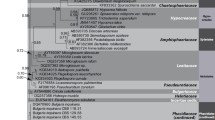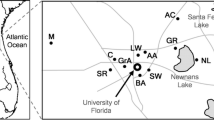Abstract
Many studies over recent years have recognised Phytophthora cryptogea as a species complex, with several distinct lineages perhaps representing as yet undescribed species. Additionally, the taxonomic status of the related species P. erythroseptica is also a matter of controversy. In this study, phylogenetic relationships were clarified using nuclear (internal transcribed spacers, ß-tubulin, heat shock protein 90, elicitin) and mitochondrial (cytochrome c oxidase subunit I, NADH dehydrogenase subunit I) gene regions. Our results showed three distinct phylogenetic lineages within P. cryptogea in combined nuclear and mitochondrial gene trees. The molecular divergence observed among these three phylogenetic lineages justifies their re-description as separate species. The first group, including the type isolate, is P. cryptogea sensu stricto, the second group corresponds to the undescribed taxon P. sp. kelmania and the third group is described here as P. pseudocryptogea sp. nov. Although some morphological differences between P. cryptogea and P. pseudocryptogea were notable, they were not sufficient to reliably distinguish these species. Moreover, in all of our phylogenetic trees (with the exception of elicitin), P. erythroseptica isolates were in a strongly supported monophyletic clade. This clade shares a recent common ancestor with P. cryptogea sensu stricto, but is clearly distinct from P. cryptogea. Our results therefore confirmed the position of P. erythroseptica as a distinct species and a close relative to the P. cryptogea species complex.





Similar content being viewed by others
References
Abad ZA, Abad J, Creswell T (2006) Species of Phytophthora and Pythium identified in a long term collection from North Carolina. Phytopathology 96:S1–S2
Andjic V, Cortinas MN, Hardy GESJ, Wingfield MJ, Burgess TI (2007) Multiple gene genealogies reveal important relationships between species of Phaeophleospora infecting Eucalyptus leaves. FEMS Microbiol Lett 268:22–33
Blair JE, Coffey MD, Park SY, Geiser DM, Kang SC (2008) A multi-locus phylogeny for Phytophthora utilizing markers derived from complete genome sequences. Fungal Genet Biol 45:266–277
Brasier CM, Hansen EM (1992) Evolutionary biology of Phytophthora. PartII. Phylogeny, population structure and speciation. Annu Rev Phytopathol 30:173–200
Brasier CM, Cooke DEL, Duncan JM, Hansen EM (2003) Multiple new phenotypic taxa from trees and riparian ecosystems in Phytophthora gonapodyides–P. megasperma ITS Clade 6, which tend to be high-temperature tolerant and either inbreeding or sterile. Mycol Res 107:277–290
Cooke DEL, Drenth A, Duncan JM, Eagels G, Brasier CM (2000) A molecular phylogeny of Phytophthora and related Oomycetes. Fun Genet Biol 30:17–32
Cunliffe C, Lonsdale D, Epton HAS (1977) Transmission of Phytophthora erythroseptica on stored potatoes. Trans Br Mycol Soc 69:27–30
Erwin DC, Ribeiro OK (1996) Phytophthora Diseases Worldwide. APS Press. American Phytopathological Society, St. Paul
Felsenstein J (1985) Confidence intervals on phylogenetics: an approach using bootstrap. Evolution 39:783–791
Förster H, Cumming MP, Coffey MD (2000) Phylogenetic relationships of Phytophthora species based on ribosomal ITS I DNA sequence analysis with emphasis on Waterhouse groups V and VI. Mycol Res 104:1055–1061
Gillings MR, Letham DB (1988) Phytophthora erythroseptica causing wilting and stunting of tomato. Austral Plant Pathol 18:3–5
Giraud T, Refregier G, Le Gac M, de Vienn DM, Hood ME (2008) Speciation in fungi. Fung Gene Biol 45:791–802
Ko WH (1978) Heterothallic Phytophthora: evidence for hormonal regulation of sexual reproduction. J Gen Microbiol 107:15–18
Kroon LPNM, Bakker FT, Van Den Bosch GBM, Bonants PJM, Flier WG (2004) Phylogenetic analysis of Phytophthora species based on mitochondrial and nuclear DNA sequences. Fungal Genet Biol 41:766–782
Kroon LPNM, Brouwer H, de Cock AWAM, Govers F (2012) The Genus Phytophthora Anno 2012. Phytopathology 102:348–364
Martin FN, Blair JE, Coffey MD (2014) Combined mitochondrial and nuclear multilocus phylogeny of the genus Phytophthora. Fungal Genet Biol 66:19–32
Mills SD, Forster H, Coffey MD (1991) Taxonomic structure of Phytophthora cryptogea and P.drechsleri based on isozyme and mitochondrial DNA analysis. Mycol Res 95:31–48
Mostowfidadeh-Ghalamfarsa R (2011) Molecular Phylogenetics of Phytophthora cryptogea and P. drechsleri. Lambert Academic Publishing, Germany
Mostowfizadeh-Ghalamfarsa R, Cooke DEL, Banihashemi Z (2006) Potato pink rot: a criterion for discrimination of Phytophthora melonis from P. drechsleri. Iran J Plant Path 41:191–201
Mostowfizadeh-Ghalamfarsa R, Panabieres F, Banihashemi Z, Cooke DEL (2010) Phylogenetic relationship of Phytophthora cryptogea Pethybr. and Laff and P. drechsleri Tucker. Fungal Biol 114:325–339
Mostowfizadeh-Ghalamfarsa R, Banihashemi Z, Cooke DEL (2014) Intraspecific genetic diversity of Phytophthora cryptogea and P. drechsleri. Iran J Plant Path 50:5–16
Nylander JAA (2004) MrModeltest v2.5. Program distributed by the author. Evolutionary Biology Centre, Uppsala University, Sweden
Peters RD, Clark RJ, Coffin AD, Sturz AV, Lambert DH, Miller JS (2005) Limited genetic diversity in North American isolates of Phytophthora erythroseptica pathogenic to potato based on RAPD analysis. Plant Dis 89:380–384
Pethybridge GH (1913) On the rotting of potato tubers by a new species of Phytophthora having a method of sexual reproduction hitherto undescribed. Sci Proc R Dublin Soc 13:529–565
Pethybridge GH, Lafferty HA (1919) A disease of tomato and other plants caused by a new species of Phytophthora. Sci Proc R Dublin Soc 15:487–505
Ronquist F, Huelsenbeck JP (2003) MrBayes 3: bayesian phylogenetic inference under mixed models. Bioinformatics 19:1572–1574
Sakalidis ML, Hardy GESJ, Burgess TI (2011) Endophytes and potential pathogens of the baobab species Adansonia gregorii; a focus on the Botryosphaeriaceae. Fungal Ecol 4:1–14
Swofford DL (2002) PAUP*: Phylogenetic analysis using parsimony (* and other methods). Sinauer Associates, Sunderland
Tucker CM (1931) Taxonomy of the genus Phytophthora de Bary. Missour Agr Expt Sta Bull 153:207
White TJ, Bruns T, Lee S, Taylor J (1990) Amplification and direct sequencing of fungal ribosomal RNA genes for phylogenetics. In: Innis MA, Gelfand DH, Sninsky JJ, White TJ (eds) PCR Protocols: a Guide to Methods and Applications. Academic Press, San Diego, pp 315–322
Acknowledgments
This work was partly funded by the Western Australian Department of Environment and Conservation and the CPSM (Centre for Phytophthora Science and Management). We are grateful to the Ministry of Science, Research and Technology of Iran for financially supporting the senior author during a sabbatical to Murdoch University in Australia. The authors would like to thank Professor N. Gudmestad and Dr. R. Taylor (Department of Plant Pathology, North Dakota State University, Fargo, USA) and Dr. K. Al-Mughrabi (New Brunswick Department of Agriculture, Wicklow, NB, Canada) for providing some of the P. erythroseptica cultures used in this study. Diane White (CPSM, Murdoch University, WA) is specially thanked for her technical help.
Author information
Authors and Affiliations
Corresponding author
Additional information
Section Editor: Marco Thines
Rights and permissions
About this article
Cite this article
Safaiefarahani, B., Mostowfizadeh-Ghalamfarsa, R., Hardy, G.E.S.J. et al. Re-evaluation of the Phytophthora cryptogea species complex and the description of a new species, Phytophthora pseudocryptogea sp. nov. Mycol Progress 14, 108 (2015). https://doi.org/10.1007/s11557-015-1129-9
Received:
Revised:
Accepted:
Published:
DOI: https://doi.org/10.1007/s11557-015-1129-9




